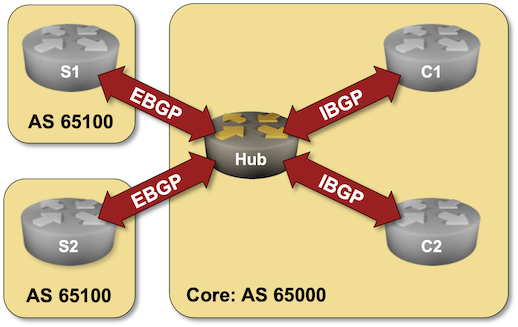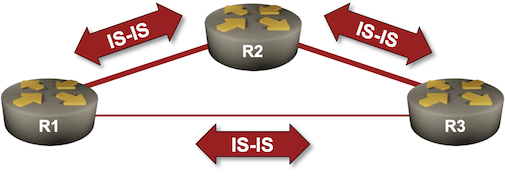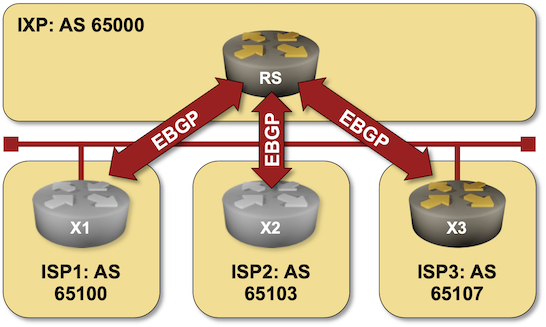Blog Posts in November 2024
Lab: Dual-Stack IS-IS Routing
Contrary to the OSPF world, where we have to use two completely different routing protocols to route IPv4 and IPv6 (unless you believe in the IPv4 address family in OSPFv3), IS-IS provided multi-protocol support from the very early days of its embracement by IETF. Adding IPv6 support was only a matter of a few extra TLVs, but even there, IETF gave us two incompatible ways of making IPv6 work with IS-IS.
Want to know more? You’ll find the details in the Dual-Stack (IPv4+IPv6) IS-IS Routing lab exercise.

IPv6 Support for Multiple Routers and Multiple Interfaces
Fernando Gont published an Individual Internet Draft (meaning it hasn’t been adopted by any IETF WG yet) describing the Problem Statement about IPv6 Support for Multiple Routers and Multiple Interfaces. It’s so nice to see someone finally acknowledging the full scope of the problem and describing it succinctly. However, I cannot help but point out that:
- I was ranting about that problem in 2009 (15 years ago) and did a summary of older rants in 2015.
- It was evident to everyone but the religious zealots that the only solution we have at the moment is either NAT (because stuff simply does not work otherwise) or host-based solutions that never got implemented (apart from a few rare cases of multipath TCP).
Anyway, Fernando wraps up his draft with:
EVPN Designs: EVPN IBGP over IPv4 EBGP
We’ll conclude the EVPN designs saga with the “most creative” design promoted by some networking vendors: running an IBGP session (carrying EVPN address family) between loopbacks advertised with EBGP IPv4 address family.

Oversimplified IBGP-over-EBGP design
There’s just a tiny gotcha in the above Works Best in PowerPoint diagram. IBGP assumes the BGP neighbors are in the same autonomous system while EBGP assumes they are in different autonomous systems. The usual way out of that OMG, I painted myself into a corner situation is to use BGP local AS functionality on the underlay EBGP session:
Dynamic BGP Peers
You might have an environment where a route reflector (or a route server) has dozens or hundreds of BGP peers. Configuring them by hand is a nightmare; you should either build a decent automation platform or use dynamic BGP neighbors – a feature you can practice in the next lab exercise.

Click here to start the lab in your browser using GitHub Codespaces (or set up your own lab infrastructure). After starting the lab environment, change the directory to session/9-dynamic and execute netlab up.
Lab: Using IS-IS Metrics
It’s time for another “the vendor IS-IS defaults are all wrong” blog post. Wide IS-IS metrics were standardized in RFC 3784 in June 2004, yet most vendors still use the ancient narrow metrics as the default setting.
Want to know more? The Using IS-IS Metrics lab exercise provides all the gory details.

Latency Numbers Every Programmer Should Know
One of the key arguments against stretched clusters (and similar stupidities) I used in my Disaster Recovery Myths presentation was the SSD read latency versus cross-site round-trip time.
Thanks to Networking Notes, I found a great infographic I can use in my next presentation (bonus points: it also works great in a terminal when fetched with curl) and a site that checks the latency of your web site from various vantage points.
Using a BGP Route Server in an Internet Exchange Point
A BGP route server is like a BGP route reflector but for EBGP sessions. In its simplest implementation, it receives BGP updates over EBGP sessions and propagates them over other EBGP sessions without inserting its own AS number in the AS path (more details).
BGP route servers are commonly used on Internet Exchange Points (IXPs), and that’s what you can practice in the BGP Route Server in an Internet Exchange Point lab exercise.

Click here to start the lab in your browser using GitHub Codespaces (or set up your own lab infrastructure). After starting the lab environment, change the directory to session/5-routeserver and execute netlab up.
Running Routing Protocols over Tunnels
James got confused by a statement made by Hannes Gredler in his IS-IS book:
Things behave really badly if the total IGP cost over the tunnel undermines the total topologies’ cost. What happens next is that the tunnel “wraps” around itself, ultimately causing a meltdown of the entire network.
Let’s unpack that, starting with “Why would you need a tunnel?”
netlab 1.9.2: STP, LAG, Cisco IOL, Edgeshark
While I was busy fixing bugs in the netlab release 1.9.2, other contributors added exciting new features:
- Jeroen van Bemmel added the spanning tree and link aggregation configuration modules, initially implemented on Arista EOS, Cumulus Linux, and FRR.
- Dan Partelly added the netlab exec command that can execute the same command on a set of network devices, support for Edgeshark, and support for Cisco IOS on Linux (IOL) and Cisco IOS layer-2 image on Linux (IOLL2), the latter after a heroic uphill battle with ancient software (part 1, part 2).
Other new features include:
